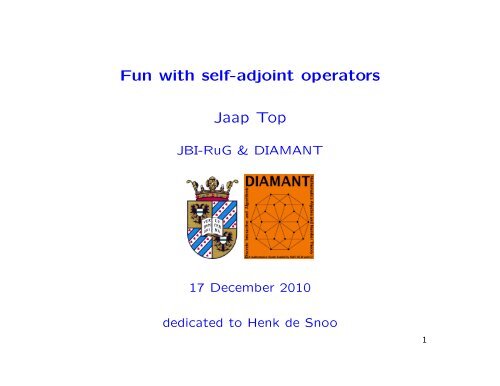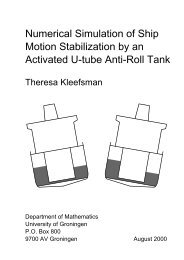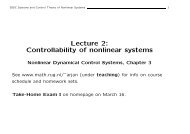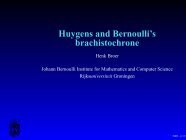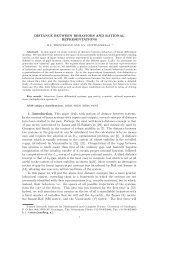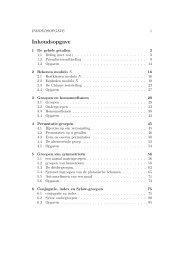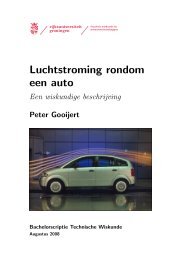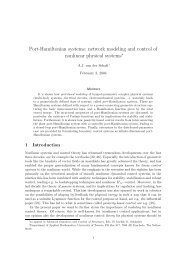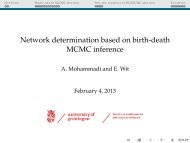Fun with self-adjoint operators Jaap Top
Fun with self-adjoint operators Jaap Top
Fun with self-adjoint operators Jaap Top
- No tags were found...
Create successful ePaper yourself
Turn your PDF publications into a flip-book with our unique Google optimized e-Paper software.
“counting” <strong>with</strong> only 0 and 1:1, 0, 1, 0, 1, 0, 1, 0, 1, 0, . . .A first example: “count” the people in this picture:3
(Solution: 1)4
A more difficult “counting” problem:(Solution: again 1)5
A ∗-“counting” problem:(once more, answer: 1)6
After counting comes arithmetic <strong>with</strong> only 0 and 1.Multiply by 0, table:Multiply by 1, table:0 × 0 = 01 × 0 = 00 × 1 = 01 × 1 = 1(outcome 0, except in the case 1 × 1)7
arithmetic, continued. . .Addition:0 + 0 = 0, 0 + 1 = 1, 1 + 0 = 1, 1 + 1 = 0.The above line implies how subtraction works:0 − 0 = 0, 1 − 1 = 0, 1 − 0 = 1, 0 − 1 = 1.Conclusion: + = − (!!)8
An example:1 + 1 + 1 = 1.9
Next, sequences of 0’s and 1’s(Henk might prefer: functions <strong>with</strong> values 0 and 1)Example: 1111001000.Such sequences/functions can be added:1111001000+1001111001=0110110001(of course, only when the sequences ‘fit’)10
We are ready for the <strong>operators</strong>.Let us agree on a fixed size for our sequences.An operator (called H) is a rule transforming sequences of oursize, to sequences of the same size,in such a way, that given any pair of sequences s and t, firstadding them and then transforming the sum using H, yields thesame result as first transforming s and t using H and then addingthe results:H(s + t) = H(s) + H(t).11
Example: “reverse the order in every sequence” is an operator.It transforms the sequence1110010100into the sequence001010011112
eversing the order (continued...)↦→13
Another operator: “change the last entry of every sequence intoa 0”So: 01111101 is transformed into 01111100and 11111100 into 11111100(i.e., the latter remains the same...)↦→14
In comes the “inner product”. The “inner product” of a pair ofsequences is one of the numbers 0, 1Rule: given the pair of sequences, “count” (in the new sense!)the number of places where both sequences have a value 1Example:11100100011010111110011011inner product: 1 + 1 + 1 + 1 + 1 = 1.15
A notion <strong>with</strong> an intimate name like this, deserves a scientificname and notation reflecting our tender feelings for it:The “inner product” is usually called “Dot”.Operator theorists (other scientists as well) write the “Dot” ofa pair of sequences s, t ass • tExample: (1110) • (1001) = 116
Definition: an operator H is called “<strong>self</strong>-<strong>adjoint</strong>” if for every pairs, t of sequences,transform s by means of H, and then take the “Dot” <strong>with</strong> t,yields the same answer astransform t by means of H, and then take the “Dot” <strong>with</strong> s.(H(s)) • t = s • (H(t))Example: “reversing the order in sequences” is a <strong>self</strong>-<strong>adjoint</strong>operator. Also “replacing the last number in every sequence bya 0” is a <strong>self</strong>-<strong>adjoint</strong> operator17
Lemma zwei (≈ Riesz representation theorem):Take H <strong>self</strong>-<strong>adjoint</strong>, compute(H(1000 · · ·)) • (1000 · · ·),(H(0100 · · ·)) • (0100 · · ·),· · · · · · ,· · · · · · ,(H(00 · · · 01)) • (00 · · · 01).Put the results in a sequence d.Then for all sequences s one has (H(s)) • s = d • s.Corollary:H(t) = d.given a <strong>self</strong>-<strong>adjoint</strong> H, there is a sequence t <strong>with</strong>18
Systems & Operators19
System (here): a network of points, each colored black (0) orwhite (1)a move: select a point, which then, together <strong>with</strong> all its directneighbors, changes colorstarting position: all points are colored black (0)goal: make moves until all points are white (1)20
Example: a closed chain of many points(solution here: select all points)21
Example: a rectangular grid; is this solvable?a small one:22
Main Theorem of Applied Systems & Operators:regardless of the chosen network, it is possible to flipall points!25
The Proof of the Main Theorem translates the problem into astatement about <strong>self</strong>-<strong>adjoint</strong> <strong>operators</strong>.This statement is then a direct consequence of the given Corollaryto Lemma zwei (Riesz representation theorem)26
Details: given a network, put the points in a sequence- - - - - - - - - - - -27
A choice of points to be selected = a sequence of 0’s and 1’s(<strong>with</strong> 1 at some place precisely when the corresponding point isselected)0 1 0 0 0 0 1 0 0 0 0 128
As a result of the selection, the network at some points changescolor. The result is expressed as a sequence: 1’s where pointschange, 0’s where they don’t.1 1 0 0 0 0 1 0 0 0 0 129
In this way, every selection is transformed into a result.This defines an operator H.H is <strong>self</strong>-<strong>adjoint</strong> (because if point M is a neighbor of point N,then also N is neighbor of M).By construction of H, the sequence d appearing in Lemma zweiis1111 · · · · · · 11As a consequence, a selection exists which results in all pointschanging color.30
quod erat demonstrandum31


